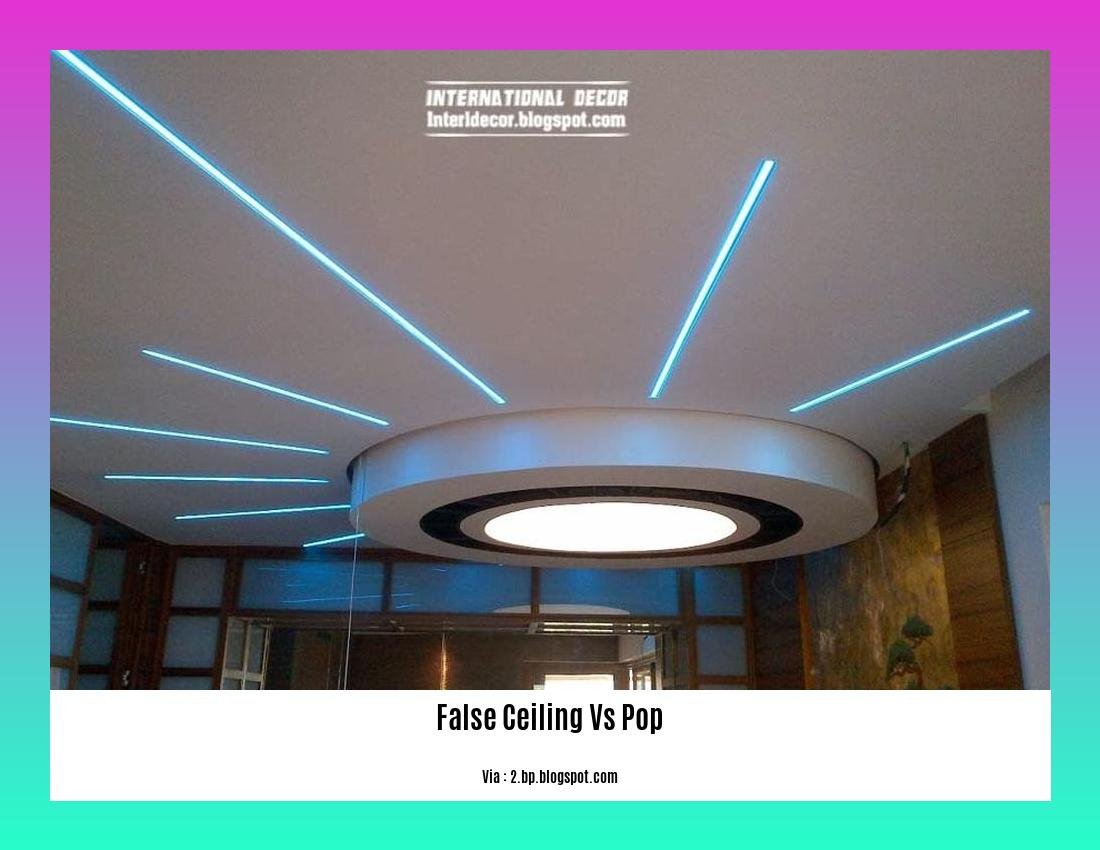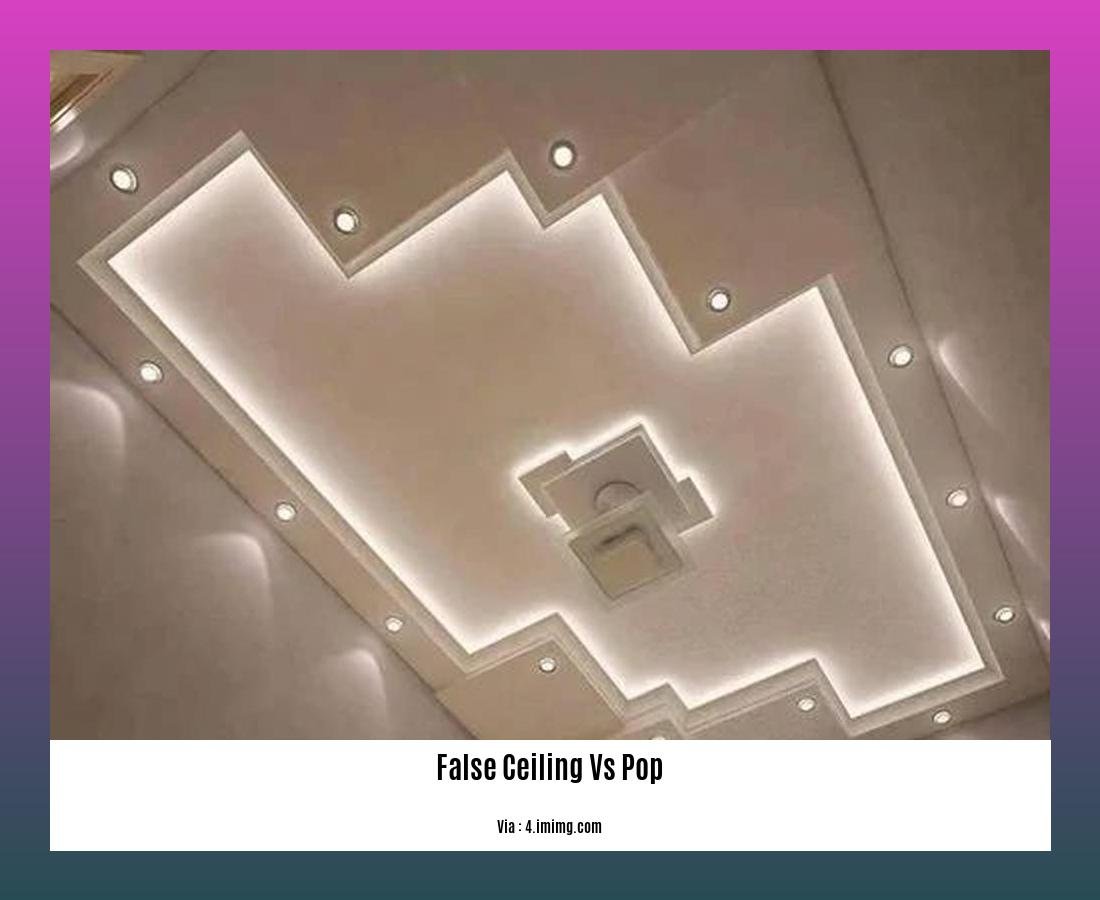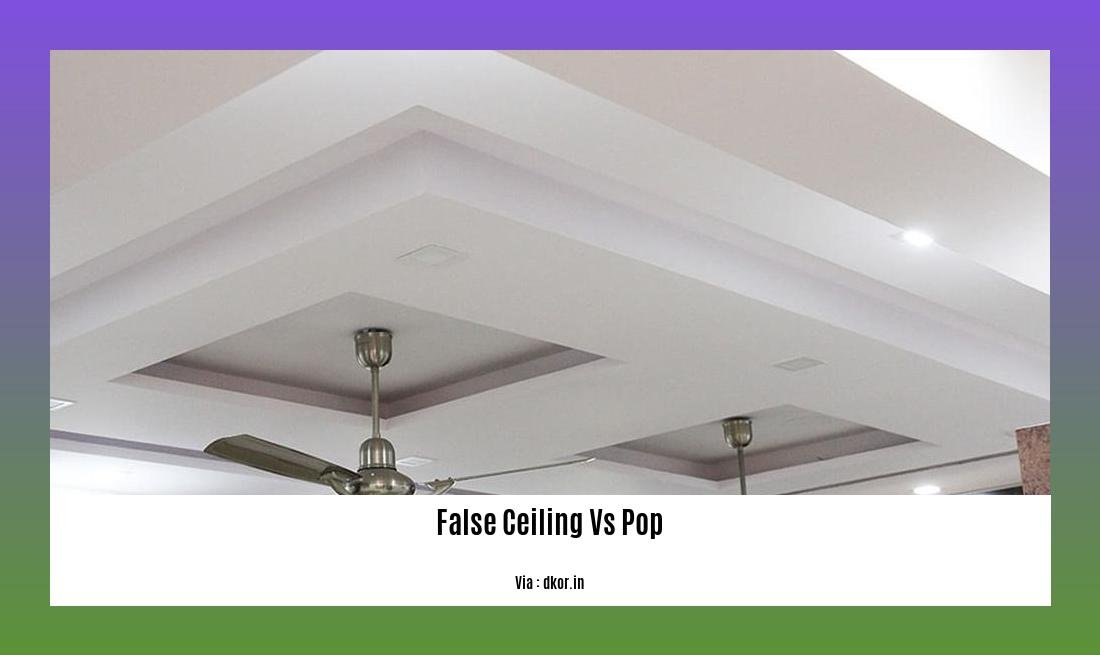False Ceiling vs POP: A Comprehensive Comparison of Two Popular Interior Design Choices
Key Takeaways:
- Gypsum ceilings offer quick and clean installation with less dust generation, thanks to its large plaster boards that result in fewer joints during installation.
- Gypsum ceilings use a jointing compound that dries quickly, making the installation process more efficient.
- POP (Plaster of Paris) ceilings, although not as commonly found in metropolitan cities, have advantages over gypsum ceilings.
- POP boards are mixed with water to form a paste and applied on a chicken mesh, allowing for seamless and moldable installation, perfect for fitting awkward corners.
- The choice between gypsum and POP ceilings ultimately depends on personal preferences and specific requirements.
False Ceiling vs Pop

When it comes to interior design choices, false ceilings and POP (Plaster of Paris) ceilings are common options that can enhance the aesthetics and functionality of a space. In this comprehensive comparison, we will explore the key differences, purposes, materials, installation processes, and pros and cons of false ceilings and pop ceilings.
False Ceiling: Functionality Meets Aesthetics
False ceilings, also known as suspended ceilings, are secondary ceilings installed below the main ceiling, creating a gap between them. These ceilings offer several advantages, making them a popular choice in both residential and commercial spaces.
Materials and Installation
False ceilings are typically constructed using materials such as gypsum, metal, or wood. However, in this comparison, we will primarily focus on gypsum ceilings. Gypsum ceilings are preferred for their quick and clean installation process, minimal dust generation, and seamless finish.
During installation, gypsum plaster boards are used, which are larger in size compared to other materials. This results in fewer joints, minimizing the chances of cracks or gaps. The boards are fixed to a metal frame or suspended with the help of wires. A jointing compound is then applied to conceal the joints, providing a smooth surface. One notable advantage of gypsum ceilings is that the jointing compound dries quickly, allowing for faster completion of the installation process.
Pros and Cons
Let’s now take a closer look at the pros and cons of false ceilings.
Pros:
- Enhanced Aesthetics: False ceilings offer a wide range of design options, allowing for creativity and customization. They can incorporate various elements such as lighting fixtures, decorative elements, or even acoustic panels, enhancing the overall aesthetics of the space.
- Design Flexibility: False ceilings can be designed to accommodate different ceiling heights, contours, and room sizes. They can also help in concealing electrical wirings, air conditioning ducts, or plumbing pipes, creating a neat and organized look.
- Improved Acoustics and Insulation: False ceilings can enhance the acoustic performance of a room, reducing echo and noise pollution. They also provide additional insulation, helping in maintaining a comfortable temperature and reducing energy consumption.
Cons:
- Reduced Ceiling Height: Since false ceilings are installed below the main ceiling, there is a slight reduction in ceiling height. This might not be suitable for spaces with low ceiling heights, as it can make the room feel smaller.
- Maintenance: False ceilings require regular maintenance and cleaning to keep them in pristine condition. Dust and dirt can accumulate on the surface, affecting both aesthetics and functionality.
POP Ceilings: Seamless Elegance
While gypsum ceilings are commonly found in metropolitan cities, POP ceilings offer distinctive advantages that make them a preferred choice in some cases.
Materials and Installation
POP ceilings are crafted using a mixture of Plaster of Paris, water, and additives. This mixture is applied on a chicken mesh or metal frame, treated, and dried to form a seamless surface. POP ceilings are known for their flexibility, as they can be molded and shaped to fit even the most awkward corners perfectly.
Pros and Cons
Now, let’s dive into the pros and cons of POP ceilings.
Pros:
- Seamless Finish: POP ceilings provide a seamless and smooth finish, eliminating the need for jointing compounds. This creates an elegant and visually appealing look, enhancing the overall aesthetics of the space.
- Design Versatility: Due to its moldable properties, POP ceilings offer endless design possibilities. Intricate designs, arches, curves, or any other design element can be easily achieved with POP, giving a unique touch to the space.
- Durability: POP ceilings are known for their durability and longevity. They can withstand wear and tear and do not develop cracks easily, making them a reliable choice for long-term use.
Cons:
- Limited Availability: POP ceiling installation requires skilled artisans, and finding experts who specialize in POP work might be challenging in some areas. This limited availability can impact the feasibility of choosing POP ceilings for certain projects.
- Time-Consuming Installation: The installation process of POP ceilings is relatively more time-consuming compared to other types of ceilings. The plaster needs sufficient time to dry and set, which can extend the overall timeline of the project.
Choosing Between False Ceilings and POP Ceilings
Ultimately, the choice between false ceilings and POP ceilings depends on personal preferences, specific requirements, and the desired aesthetic appeal for a space. False ceilings offer a range of design options, ease of installation, and functional advantages such as improved acoustics and insulation. On the other hand, POP ceilings provide seamless elegance, unique design possibilities, and increased durability.
To make an informed decision, it is essential to consider factors such as budget, project timeline, availability of skilled artisans, and the overall design vision for the space. Consulting with an experienced interior designer can help navigate through the options and ensure the chosen ceiling type aligns with the desired outcome.
Whether it’s a false ceiling or a POP ceiling, both choices bring their own charm to a space. By understanding the differences and weighing the pros and cons, one can create a visually appealing and functional environment that suits their individual style and requirements.
-
Don’t miss out on the intense and captivating movie experience of “Bedroom Room Eyes”! Download it now at Bedroom Room Eyes Movie Download.
-
Dive into the mind-bending concepts discussed in Chapter 5 of “How It Works” with this summary. Discover the latest insights and revelations at Chapter 5 How It Works Summary.
-
Looking for an amazing deal on office shoes in Romania? Look no further! Get your promo code for Office Shoes at Cod Promotional Office Shoes Romania.
-
Enhance your comfort and productivity at work with an ergonomic office chair. Find the perfect fit for you in Germany at Ergonomic Office Chair Germany.
Materials used in False Ceilings and Pop Ceilings
False ceilings and pop ceilings are popular choices in interior design, offering numerous benefits and design options. In this article, we will explore the various materials used in false ceilings and pop ceilings, allowing you to make an informed decision when it comes to creating your ideal space.
Gypsum: Lightweight and Versatile
One of the most popular materials used in false ceilings is gypsum. Gypsum offers a smooth finish to the surface and is known for its lightweight and versatility. It is easy to install, making it a preferred choice for many homeowners and interior designers[^1].
Wood: Elegance and Sophistication
Wood has been a classic choice for creating ceilings and false ceilings due to its elegance and sophistication. By incorporating wood into your ceiling design, you can add a touch of warmth and natural beauty to your space. Wood offers a timeless appeal that can complement a variety of interior styles.
PVC: Durability and Low Maintenance
Another popular material used in false ceilings is PVC or polyvinyl chloride ceiling panels. PVC panels are highly durable, offering resistance to moisture and humidity. They are also easy to clean and require minimal maintenance. These factory-made panels are lightweight and simple to install, making them a convenient choice for both residential and commercial spaces[^1].
Metal: Impressive and Unique
Metals such as aluminum and galvanized iron are commonly used to create impressive false ceilings. These metals offer durability and a sleek, modern aesthetic. Additionally, metals like brass and copper can be used for a more unique and eye-catching design, depending on your preferences and availability[^2].
Key Takeaways:
- Gypsum is a lightweight and versatile material commonly used in false ceilings, offering a smooth finish to the surface[^1].
- Wood is a classic choice that adds elegance and sophistication to space, allowing for a timeless appeal[^2].
- PVC panels are highly durable and low maintenance, making them a convenient choice for both residential and commercial spaces[^1].
- Metals like aluminum, galvanized iron, brass, and copper offer durability and unique design options for false ceilings[^2].
Sources:
[^1] MagicBricks
[^2] [To be added]
Installation Process of False Ceilings and Pop Ceilings

False ceilings and pop (Plaster of Paris) ceilings are two popular choices for adding visual appeal and functionality to interior spaces. Each option has its own installation process and unique characteristics. In this article, we will explore the installation process of false ceilings and pop ceilings, highlighting their differences and key considerations.
Installing False Ceilings
False ceilings, also known as drop ceilings or suspended ceilings, are secondary ceilings installed below the main ceiling. They are commonly used in residential and commercial spaces to enhance aesthetics, provide insulation, and hide structural components such as wirings or pipes. The installation process of false ceilings involves the following steps:
-
Determine the objective and design: Before beginning the installation, it is important to define the purpose of the false ceiling and plan its design. Consider factors such as lighting requirements, acoustics, and overall aesthetic vision.
-
Measure and mark: Measure the dimensions of the space and mark the layout of the false ceiling on the main ceiling. This will serve as a guide during the installation process.
-
Prepare the materials: Based on the design and objective, select the appropriate material for the false ceiling. Common materials include gypsum, metal, wood, or PVC. Ensure that the chosen material is suitable for the desired outcome.
-
Create a framework: Install a metal framework or a wooden framework to support the false ceiling panels. The framework should be securely attached to the main ceiling, ensuring stability and longevity.
-
Install the false ceiling panels: Once the framework is in place, attach the false ceiling panels to the framework. This may involve cutting the panels to fit the desired dimensions and ensuring a seamless installation.
-
Finishing touches: Apply finishing touches such as paint, texture, or decorative elements to enhance the appearance of the false ceiling. Take care to ensure consistency with the overall design vision.
Installing Pop Ceilings
Pop ceilings, also known as plaster of Paris ceilings, are crafted using a mixture of Plaster of Paris, water, and additives. They are known for their seamless finish and design versatility. The installation process of pop ceilings involves the following steps:
-
Prepare the surface: Ensure that the surface of the main ceiling is clean, smooth, and free from any obstructions. Remove any existing paint or loose materials that may interfere with the adhesion of the plaster.
-
Create a framework: Similar to false ceilings, pop ceilings also require a framework to support the plaster. Install a metal or wooden framework to provide stability and support.
-
Apply the plaster: Mix the plaster of Paris with water to form a paste. Apply the paste evenly on a chicken mesh that is attached to the framework. Use a trowel or other appropriate tools to spread the plaster smoothly and achieve the desired finish.
-
Dry and sand: Allow the plaster to dry completely. Once dry, sand the surface to achieve a smooth and uniform finish. This step may require multiple rounds of sanding to achieve the desired result.
-
Paint or texture: After sanding, the pop ceiling is ready for paint or texture application. Choose the desired color or texture and apply it to the surface. Take care to follow the manufacturer’s instructions and ensure even coverage.
Key Takeaways:
- The installation process of false ceilings involves measuring, marking, preparing materials, creating a framework, installing panels, and applying finishing touches.
- Pop ceilings are installed by preparing the surface, creating a framework, applying plaster, drying, sanding, and painting or texturing.
- False ceilings offer design flexibility, improved acoustics, and insulation, while pop ceilings provide a seamless finish and design versatility.
- The choice between false ceilings and pop ceilings depends on personal preferences, budget, and specific project requirements.
Sources:
1. MagicBricks – False Ceiling Materials
2. NoBroker – Gypsum vs POP: Which is Better for False Ceilings?
Pros and Cons of False Ceilings and Pop Ceilings
False ceilings and pop ceilings are two popular choices when it comes to interior design. These options offer various advantages and considerations that homeowners and designers need to be aware of. In this article, we will explore the pros and cons of false ceilings and pop ceilings, helping you make an informed decision for your space.
False Ceilings: Enhancing Aesthetics and Functionality
False ceilings, also known as drop ceilings or suspended ceilings, are secondary ceilings installed below the main ceiling. They offer a range of benefits that can greatly enhance the aesthetics and functionality of a space.
Pros of False Ceilings
- Enhanced aesthetics: False ceilings provide a way to transform the look and feel of a room. They offer design flexibility, allowing you to experiment with various materials, shapes, and finishes to create a unique and visually appealing ceiling design.
- Improved acoustics and insulation: False ceilings help to reduce noise levels within a space by absorbing sound. They can create a more peaceful and comfortable environment by minimizing echoes and external disturbances. Additionally, false ceilings can provide insulation properties, keeping the room cooler in summers and warmer in winters.
- Design versatility: False ceilings can accommodate various lighting fixtures, including recessed lights, spotlights, pendant lights, or chandeliers. This enables you to create different lighting effects and ambiances based on your requirements and preferences.
- Easy maintenance: False ceilings are relatively easy to maintain. They can be cleaned periodically using a soft cloth or vacuum cleaner to remove dust and dirt. Regular maintenance can help preserve the aesthetic appeal of the false ceiling and extend its lifespan.
Cons of False Ceilings
- Reduced ceiling height: False ceilings can lower the height of a room. This may not be suitable for spaces with low ceilings or if you prefer a lofty and spacious feel.
- Regular maintenance: While maintenance is relatively easy, false ceilings do require regular attention to keep them clean and in good condition. If not properly maintained, they can accumulate dust and lose their visual appeal.
- Installation process: The installation of false ceilings usually involves hiring a professional to ensure proper fitting and alignment. This adds to the overall cost and may require more time and effort compared to other ceiling options.
Pop Ceilings: A Seamless and Durable Finish
POP (Plaster of Paris) ceilings provide a seamless and elegant finish to ceilings. They offer their own set of advantages and considerations in comparison to false ceilings.
Pros of Pop Ceilings
- Seamless finish: Pop ceilings provide a smooth and seamless finish, giving the illusion of an extended ceiling. This adds a touch of sophistication and elegance to the space.
- Design flexibility: With POP, you can explore various design options and create custom patterns, shapes, and textures. This allows for greater design versatility and the ability to tailor the ceiling to match your specific vision.
- Durability: Pop ceilings are known for their durability and resistance to cracks. They can withstand minor movements and vibrations without developing cracks easily.
- Paint adhesion: POP ceilings have good adhesion qualities, making them an excellent choice if you plan to paint the ceiling in the future.
Cons of Pop Ceilings
- Need for skilled artisans: The installation of pop ceilings requires the expertise of skilled artisans who have experience working with Plaster of Paris. Finding skilled professionals can sometimes be challenging, especially in certain regions.
- Time-consuming installation: Compared to false ceilings, pop ceilings generally take more time to install. The process involves multiple steps, including the preparation of the mixture, application on a chicken mesh, treatment, and drying.
- Limited availability of materials: POP ceilings may have limited availability of materials and finishes compared to false ceilings. This can limit your design options and customization choices.
Key Takeaways:
- False ceilings offer enhanced aesthetics, improved acoustics, and insulation benefits. They provide design versatility, accommodate various lighting fixtures, and are relatively easy to maintain. However, they may reduce ceiling height and require regular maintenance.
- Pop ceilings provide a seamless and sophisticated finish, along with design flexibility and durability. They have good paint adhesion qualities. However, they require skilled artisans for installation, have longer installation times, and limited material availability.
In conclusion, both false ceilings and pop ceilings have their own unique set of pros and cons. The choice between the two depends on factors such as personal preferences, budget, required installation time, and the availability of skilled artisans. Consulting with an experienced interior designer can help you make an informed decision based on your specific requirements and desired aesthetic appeal.
Sources:
– DesignCafe
– NoBroker
FAQ
Q1: What is the difference between a false ceiling and a POP ceiling?
A1: A false ceiling refers to a secondary ceiling installed below the main ceiling to enhance the aesthetics of a space, while a POP (Plaster of Paris) ceiling specifically refers to a type of false ceiling made from a mixture of POP powder and water.
Q2: Which is easier to install, a gypsum false ceiling or a POP false ceiling?
A2: Gypsum false ceilings are easier to install compared to POP false ceilings. Gypsum boards are prefabricated and can be easily attached to a metal framework, while POP ceilings require more expertise and skill to apply the paste onto a chicken mesh.
Q3: Do gypsum false ceilings or POP false ceilings absorb sound better?
A3: Gypsum false ceilings have sound-absorbing properties, making them effective in reducing noise levels within a space. In contrast, POP false ceilings do not possess sound-absorbing capabilities.
Q4: Which type of false ceiling is more cost-effective, gypsum or POP?
A4: In terms of cost-effectiveness, POP false ceilings are generally cheaper compared to gypsum false ceilings. The materials for POP ceilings, including the POP powder, water, and chicken mesh, are relatively less expensive.
Q5: Can both gypsum and POP false ceilings be customized to suit different styles and preferences?
A5: Yes, both gypsum and POP false ceilings offer a wide range of design options and can be customized according to individual styles and preferences. This allows for the creation of unique and visually appealing ceiling designs.
- Modern White Kitchen Backsplash: A Guide to Stylish Kitchen Designs - November 23, 2025
- White Backsplash Ideas: Simple Ways to Refresh Your Kitchen Space - November 22, 2025
- Kitchen Backsplash For White Kitchen: Ideas To Inspire Your Renovation - November 21, 2025










